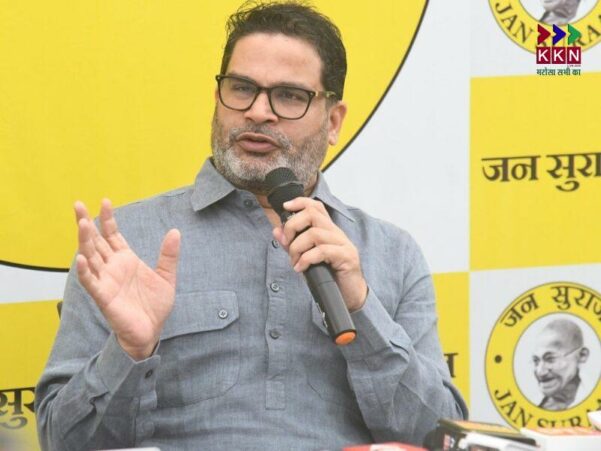
As the vote counting for Bihar’s 2025 Assembly elections began, early trends revealed that Prashant Kishor’s Jan Suraaj party was struggling to make any significant breakthrough. Despite months of high-profile campaigning, including a 3,000km padayatra and extensive outreach efforts, the party failed to secure any major leads. Jan Suraaj, which had promised to bring a fresh political alternative to the state, showed no tangible results from its intense electoral campaign.
The Election Commission of India’s official data, which began rolling out early results, showed no significant leads for Jan Suraaj in any of the 243 constituencies. While television channels briefly reported that the party was ahead in up to four constituencies by 9:30 AM, these leads vanished by 10:30 AM. Among the candidates leading in early trends was Jan Suraaj’s Ritesh Pandey, a Bhojpuri actor contesting from Kargahar. However, his early advantage disappeared soon after, highlighting the party’s struggles to convert its initial momentum into actual electoral gains.
Jan Suraaj’s Campaign Strategy and Ambitions
Jan Suraaj contested 238 of the 243 Assembly seats, fielding candidates from diverse backgrounds, including popular social media figures like Bhojpuri singer Ritesh Pandey and YouTuber Manish Kashyap. Kishor, known for his work as an election strategist, had built his political movement through a combination of large public rallies and a mass outreach campaign. He positioned his party as a disruptor, claiming it would tackle major issues in Bihar such as migration, education, and the state’s liquor ban.
Throughout his campaign, Kishor made bold claims, stating that Jan Suraaj would either “win more than 150 seats or fewer than 10,” framing this as a sign of the party’s ambition and ideological clarity. His remarks were meant to highlight Jan Suraaj’s desire to bring change to Bihar’s political landscape. However, as the election results began to unfold, it became evident that these aspirations had not materialized into electoral success.
Factors Behind Jan Suraaj’s Struggles
Political analysts have pointed out several reasons for Jan Suraaj’s apparent collapse in the election. One major criticism of Kishor’s strategy was his decision not to contest the election himself. Initially, there was speculation that Kishor might challenge Tejashwi Yadav, the Chief Ministerial candidate from the Rashtriya Janata Dal (RJD), in the high-profile Raghopur constituency. However, Kishor ultimately chose not to enter the race, a move that many analysts believe weakened his party’s position. The absence of a prominent face like Kishor on the ballot may have contributed to the party’s inability to gain significant traction among voters.
Another factor in Jan Suraaj’s electoral downfall was the loss of momentum as the election date approached. Despite Kishor’s extensive outreach and the energy generated during his padayatra, the movement seemed to struggle with converting its mobilization efforts into votes. As the election season progressed, Jan Suraaj was unable to translate its rallies and publicity into the kind of grassroots support needed to make a mark in Bihar’s complex political environment.
Kishor’s Commitment Despite Disappointing Trends
Despite the disappointing early results, Prashant Kishor has remained firm in his resolve to continue his political journey in Bihar. Responding to exit polls that indicated a lackluster performance, he expressed his commitment to the state’s future. In his statement, Kishor emphasized that he had invested his entire life for the betterment of Bihar. “I personally have nothing much to lose. I put my entire life for the betterment of Bihar, but if people want to stay in the present conditions, it is their choice,” Kishor said.
His words reflect his belief in his cause, even in the face of apparent electoral defeat. Kishor remains determined to push forward with his political project, despite the setbacks his party faced in this election. His persistence suggests that he is in for the long haul, with plans to continue engaging with Bihar’s political landscape, regardless of the current electoral outcome.
The Future of Jan Suraaj and Bihar’s Politics
As the final results come in, it’s clear that Jan Suraaj’s attempt to reshape Bihar’s political landscape faces a significant challenge. While Kishor’s campaign generated a lot of attention and hope for a fresh alternative, the early trends indicate that the party was unable to break through Bihar’s deeply entrenched political alliances.
The results also highlight the dominance of the traditional political players in the state, such as the RJD and NDA. Despite Kishor’s efforts to bring about change, the election results indicate that voters in Bihar have largely remained loyal to established parties and their leadership.
Looking forward, Kishor may need to reevaluate his approach to Bihar’s politics. The challenges of creating a new political force in a state as complex as Bihar are immense, and his future efforts will likely need to be more strategically aligned with the needs and preferences of the electorate. Whether Jan Suraaj can gain any meaningful foothold in Bihar’s future elections will depend on how effectively Kishor can adapt his strategy to the evolving political environment.
In conclusion, the early trends from Bihar’s 2025 Assembly elections show that Prashant Kishor’s Jan Suraaj party has failed to make a significant electoral impact. Despite extensive campaigning, including a long padayatra and large rallies, the party was unable to secure any major leads. However, Kishor has shown resilience, vowing to continue his political journey in Bihar. As the state’s politics continue to evolve, it remains to be seen how Kishor’s future efforts will shape the landscape of Bihar’s political arena.


